(PDF) Managing Continuous Organisational Improvement
VerifiedAdded on 2021/02/19
|14
|3780
|23
AI Summary
Contribute Materials
Your contribution can guide someone’s learning journey. Share your
documents today.
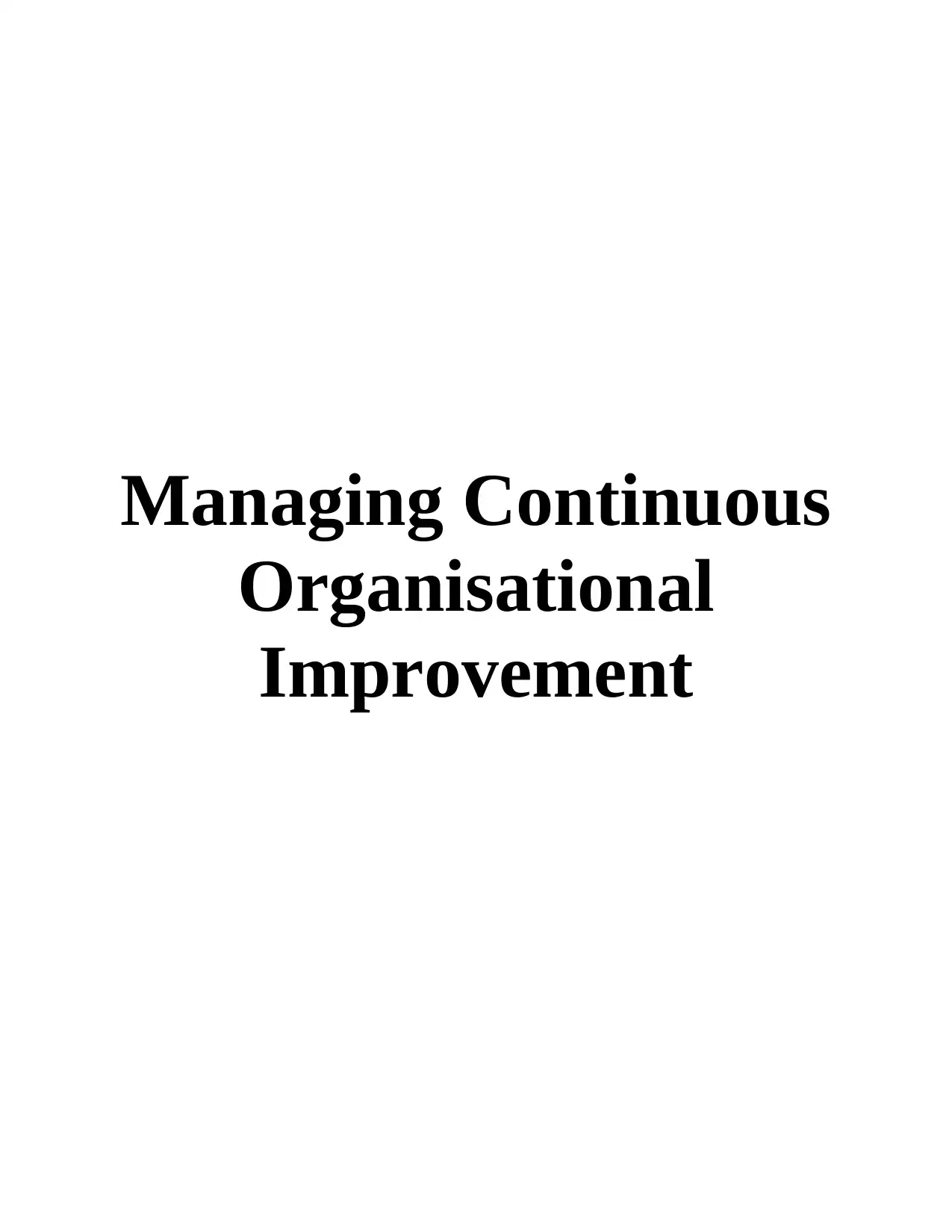
Managing Continuous
Organisational
Improvement
Organisational
Improvement
Secure Best Marks with AI Grader
Need help grading? Try our AI Grader for instant feedback on your assignments.

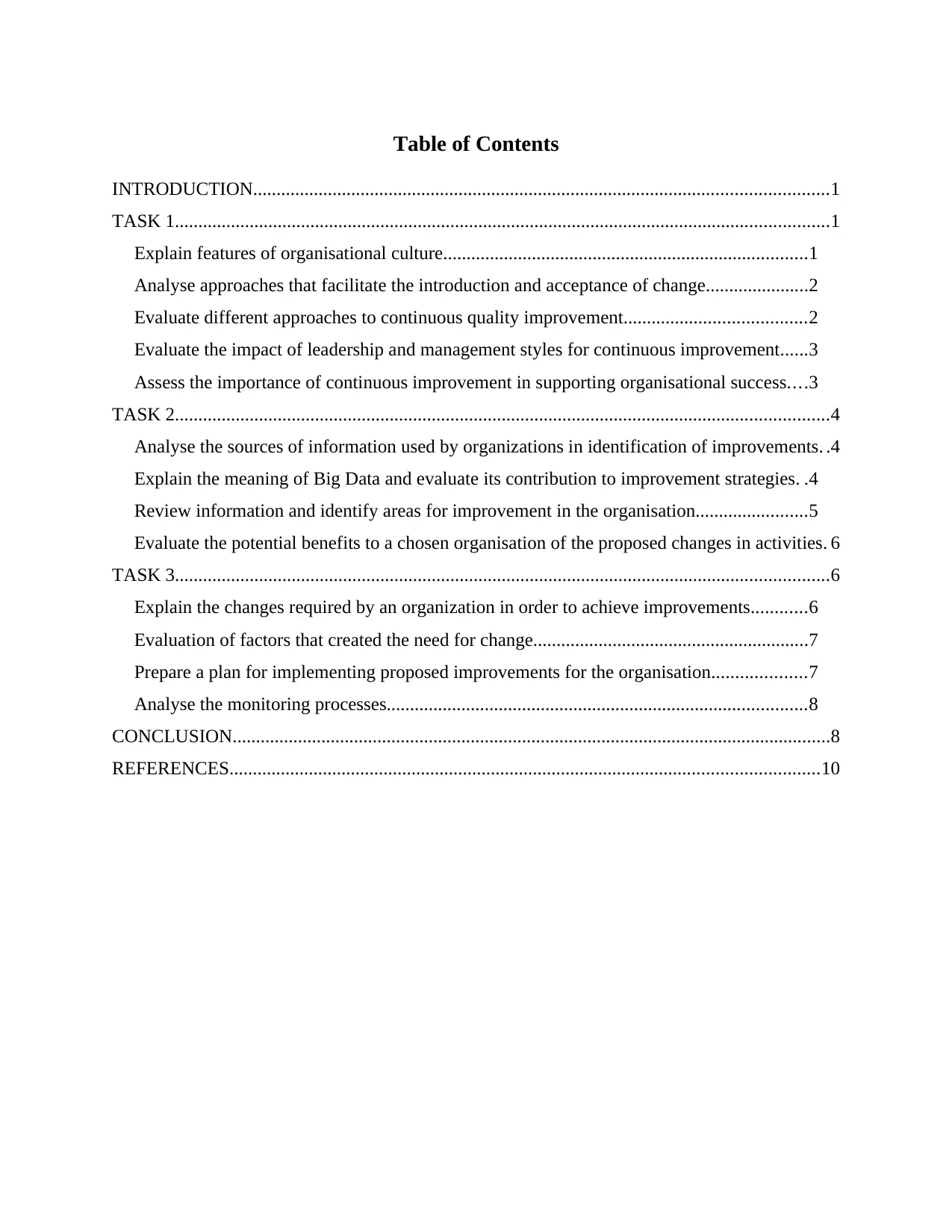
Table of Contents
INTRODUCTION...........................................................................................................................1
TASK 1............................................................................................................................................1
Explain features of organisational culture..............................................................................1
Analyse approaches that facilitate the introduction and acceptance of change......................2
Evaluate different approaches to continuous quality improvement.......................................2
Evaluate the impact of leadership and management styles for continuous improvement......3
Assess the importance of continuous improvement in supporting organisational success....3
TASK 2............................................................................................................................................4
Analyse the sources of information used by organizations in identification of improvements. .4
Explain the meaning of Big Data and evaluate its contribution to improvement strategies. .4
Review information and identify areas for improvement in the organisation........................5
Evaluate the potential benefits to a chosen organisation of the proposed changes in activities. 6
TASK 3............................................................................................................................................6
Explain the changes required by an organization in order to achieve improvements............6
Evaluation of factors that created the need for change...........................................................7
Prepare a plan for implementing proposed improvements for the organisation....................7
Analyse the monitoring processes..........................................................................................8
CONCLUSION................................................................................................................................8
REFERENCES..............................................................................................................................10
INTRODUCTION...........................................................................................................................1
TASK 1............................................................................................................................................1
Explain features of organisational culture..............................................................................1
Analyse approaches that facilitate the introduction and acceptance of change......................2
Evaluate different approaches to continuous quality improvement.......................................2
Evaluate the impact of leadership and management styles for continuous improvement......3
Assess the importance of continuous improvement in supporting organisational success....3
TASK 2............................................................................................................................................4
Analyse the sources of information used by organizations in identification of improvements. .4
Explain the meaning of Big Data and evaluate its contribution to improvement strategies. .4
Review information and identify areas for improvement in the organisation........................5
Evaluate the potential benefits to a chosen organisation of the proposed changes in activities. 6
TASK 3............................................................................................................................................6
Explain the changes required by an organization in order to achieve improvements............6
Evaluation of factors that created the need for change...........................................................7
Prepare a plan for implementing proposed improvements for the organisation....................7
Analyse the monitoring processes..........................................................................................8
CONCLUSION................................................................................................................................8
REFERENCES..............................................................................................................................10
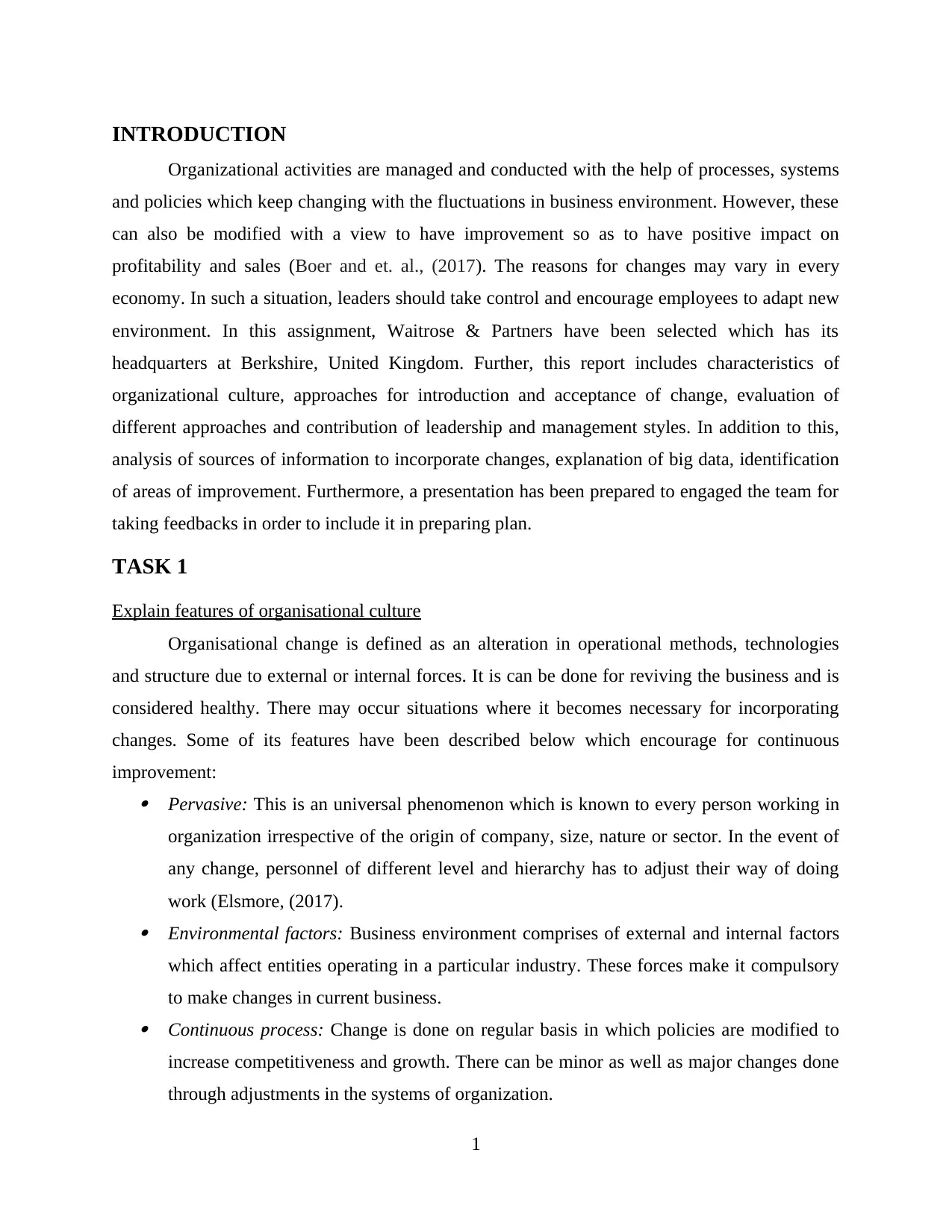
INTRODUCTION
Organizational activities are managed and conducted with the help of processes, systems
and policies which keep changing with the fluctuations in business environment. However, these
can also be modified with a view to have improvement so as to have positive impact on
profitability and sales (Boer and et. al., (2017). The reasons for changes may vary in every
economy. In such a situation, leaders should take control and encourage employees to adapt new
environment. In this assignment, Waitrose & Partners have been selected which has its
headquarters at Berkshire, United Kingdom. Further, this report includes characteristics of
organizational culture, approaches for introduction and acceptance of change, evaluation of
different approaches and contribution of leadership and management styles. In addition to this,
analysis of sources of information to incorporate changes, explanation of big data, identification
of areas of improvement. Furthermore, a presentation has been prepared to engaged the team for
taking feedbacks in order to include it in preparing plan.
TASK 1
Explain features of organisational culture
Organisational change is defined as an alteration in operational methods, technologies
and structure due to external or internal forces. It is can be done for reviving the business and is
considered healthy. There may occur situations where it becomes necessary for incorporating
changes. Some of its features have been described below which encourage for continuous
improvement: Pervasive: This is an universal phenomenon which is known to every person working in
organization irrespective of the origin of company, size, nature or sector. In the event of
any change, personnel of different level and hierarchy has to adjust their way of doing
work (Elsmore, (2017). Environmental factors: Business environment comprises of external and internal factors
which affect entities operating in a particular industry. These forces make it compulsory
to make changes in current business. Continuous process: Change is done on regular basis in which policies are modified to
increase competitiveness and growth. There can be minor as well as major changes done
through adjustments in the systems of organization.
1
Organizational activities are managed and conducted with the help of processes, systems
and policies which keep changing with the fluctuations in business environment. However, these
can also be modified with a view to have improvement so as to have positive impact on
profitability and sales (Boer and et. al., (2017). The reasons for changes may vary in every
economy. In such a situation, leaders should take control and encourage employees to adapt new
environment. In this assignment, Waitrose & Partners have been selected which has its
headquarters at Berkshire, United Kingdom. Further, this report includes characteristics of
organizational culture, approaches for introduction and acceptance of change, evaluation of
different approaches and contribution of leadership and management styles. In addition to this,
analysis of sources of information to incorporate changes, explanation of big data, identification
of areas of improvement. Furthermore, a presentation has been prepared to engaged the team for
taking feedbacks in order to include it in preparing plan.
TASK 1
Explain features of organisational culture
Organisational change is defined as an alteration in operational methods, technologies
and structure due to external or internal forces. It is can be done for reviving the business and is
considered healthy. There may occur situations where it becomes necessary for incorporating
changes. Some of its features have been described below which encourage for continuous
improvement: Pervasive: This is an universal phenomenon which is known to every person working in
organization irrespective of the origin of company, size, nature or sector. In the event of
any change, personnel of different level and hierarchy has to adjust their way of doing
work (Elsmore, (2017). Environmental factors: Business environment comprises of external and internal factors
which affect entities operating in a particular industry. These forces make it compulsory
to make changes in current business. Continuous process: Change is done on regular basis in which policies are modified to
increase competitiveness and growth. There can be minor as well as major changes done
through adjustments in the systems of organization.
1
Secure Best Marks with AI Grader
Need help grading? Try our AI Grader for instant feedback on your assignments.
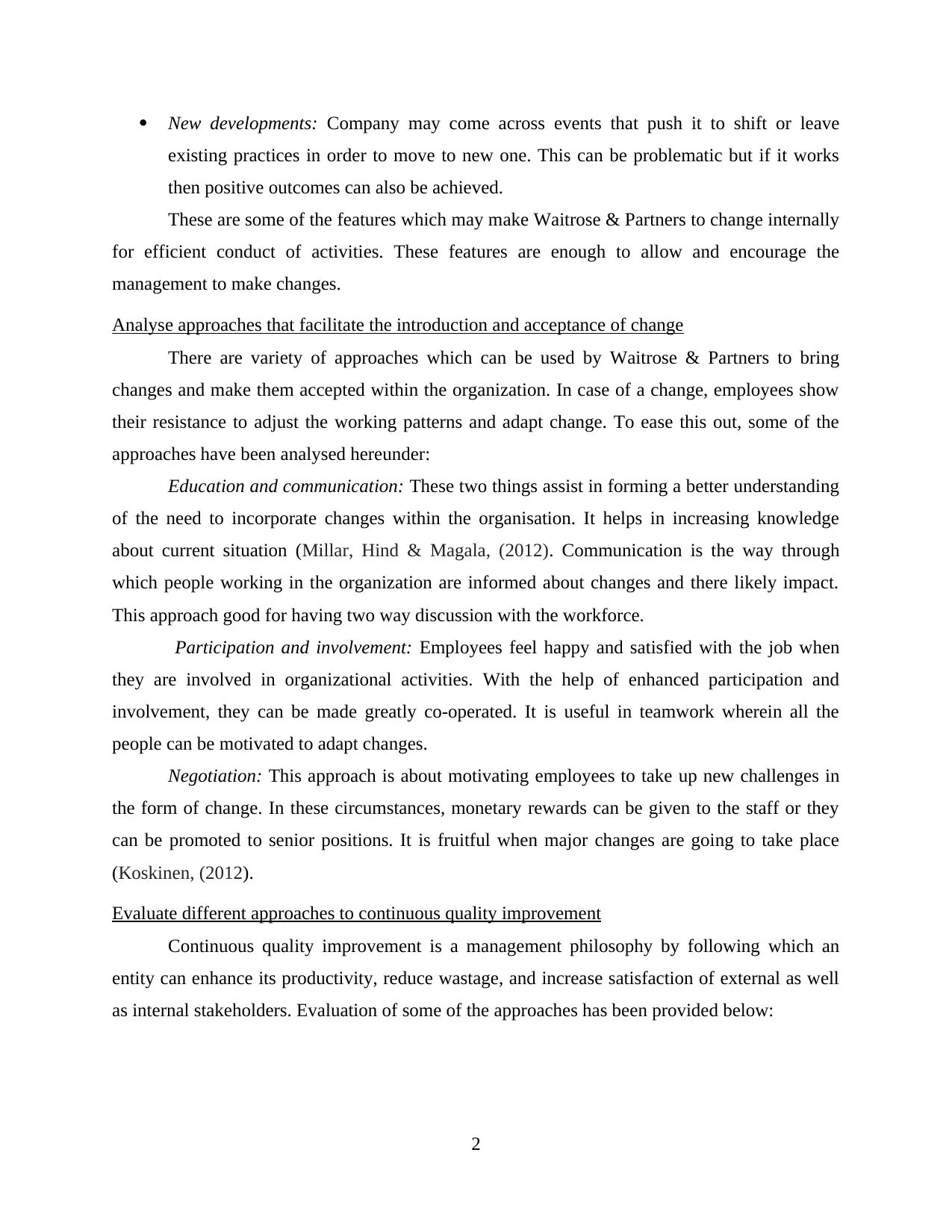
New developments: Company may come across events that push it to shift or leave
existing practices in order to move to new one. This can be problematic but if it works
then positive outcomes can also be achieved.
These are some of the features which may make Waitrose & Partners to change internally
for efficient conduct of activities. These features are enough to allow and encourage the
management to make changes.
Analyse approaches that facilitate the introduction and acceptance of change
There are variety of approaches which can be used by Waitrose & Partners to bring
changes and make them accepted within the organization. In case of a change, employees show
their resistance to adjust the working patterns and adapt change. To ease this out, some of the
approaches have been analysed hereunder:
Education and communication: These two things assist in forming a better understanding
of the need to incorporate changes within the organisation. It helps in increasing knowledge
about current situation (Millar, Hind & Magala, (2012). Communication is the way through
which people working in the organization are informed about changes and there likely impact.
This approach good for having two way discussion with the workforce.
Participation and involvement: Employees feel happy and satisfied with the job when
they are involved in organizational activities. With the help of enhanced participation and
involvement, they can be made greatly co-operated. It is useful in teamwork wherein all the
people can be motivated to adapt changes.
Negotiation: This approach is about motivating employees to take up new challenges in
the form of change. In these circumstances, monetary rewards can be given to the staff or they
can be promoted to senior positions. It is fruitful when major changes are going to take place
(Koskinen, (2012).
Evaluate different approaches to continuous quality improvement
Continuous quality improvement is a management philosophy by following which an
entity can enhance its productivity, reduce wastage, and increase satisfaction of external as well
as internal stakeholders. Evaluation of some of the approaches has been provided below:
2
existing practices in order to move to new one. This can be problematic but if it works
then positive outcomes can also be achieved.
These are some of the features which may make Waitrose & Partners to change internally
for efficient conduct of activities. These features are enough to allow and encourage the
management to make changes.
Analyse approaches that facilitate the introduction and acceptance of change
There are variety of approaches which can be used by Waitrose & Partners to bring
changes and make them accepted within the organization. In case of a change, employees show
their resistance to adjust the working patterns and adapt change. To ease this out, some of the
approaches have been analysed hereunder:
Education and communication: These two things assist in forming a better understanding
of the need to incorporate changes within the organisation. It helps in increasing knowledge
about current situation (Millar, Hind & Magala, (2012). Communication is the way through
which people working in the organization are informed about changes and there likely impact.
This approach good for having two way discussion with the workforce.
Participation and involvement: Employees feel happy and satisfied with the job when
they are involved in organizational activities. With the help of enhanced participation and
involvement, they can be made greatly co-operated. It is useful in teamwork wherein all the
people can be motivated to adapt changes.
Negotiation: This approach is about motivating employees to take up new challenges in
the form of change. In these circumstances, monetary rewards can be given to the staff or they
can be promoted to senior positions. It is fruitful when major changes are going to take place
(Koskinen, (2012).
Evaluate different approaches to continuous quality improvement
Continuous quality improvement is a management philosophy by following which an
entity can enhance its productivity, reduce wastage, and increase satisfaction of external as well
as internal stakeholders. Evaluation of some of the approaches has been provided below:
2
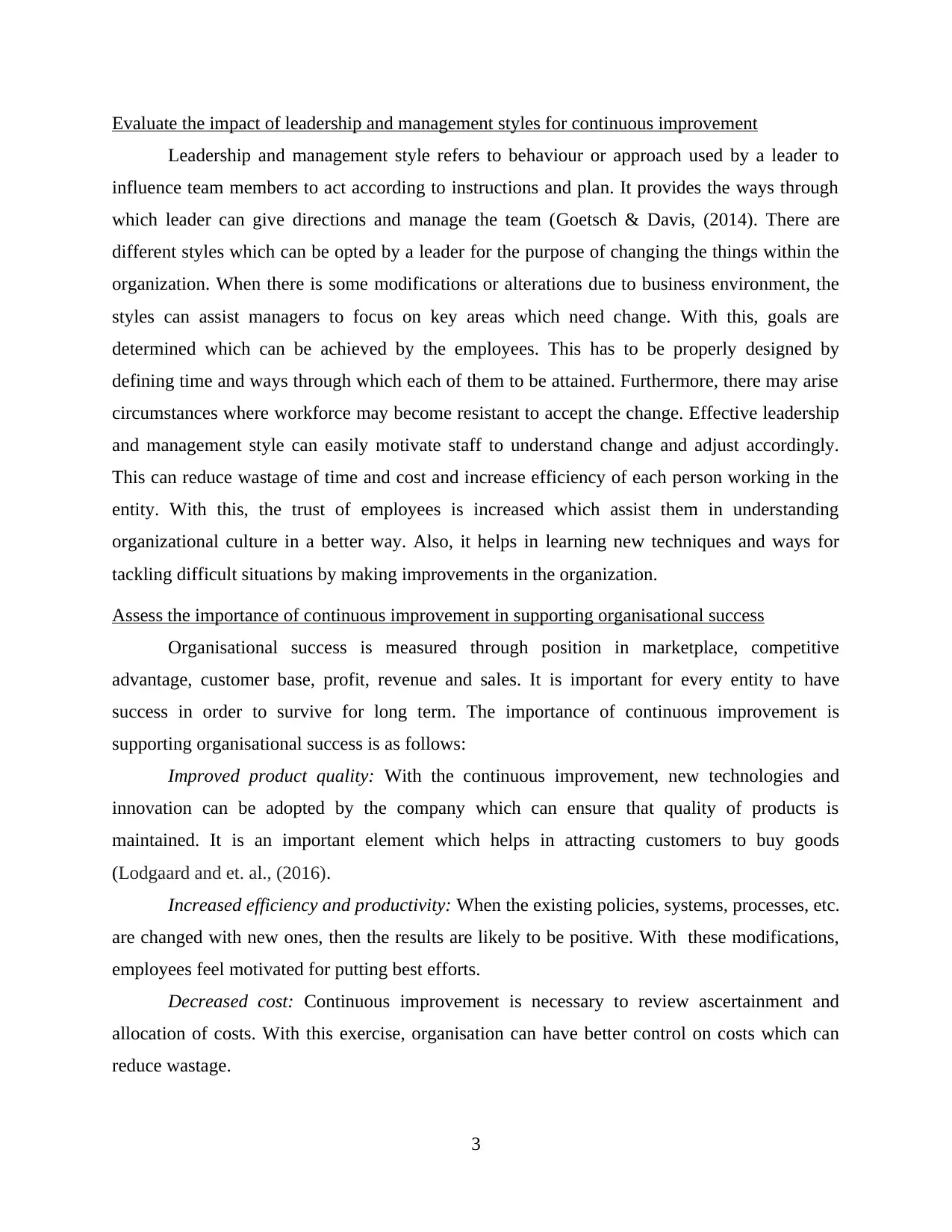
Evaluate the impact of leadership and management styles for continuous improvement
Leadership and management style refers to behaviour or approach used by a leader to
influence team members to act according to instructions and plan. It provides the ways through
which leader can give directions and manage the team (Goetsch & Davis, (2014). There are
different styles which can be opted by a leader for the purpose of changing the things within the
organization. When there is some modifications or alterations due to business environment, the
styles can assist managers to focus on key areas which need change. With this, goals are
determined which can be achieved by the employees. This has to be properly designed by
defining time and ways through which each of them to be attained. Furthermore, there may arise
circumstances where workforce may become resistant to accept the change. Effective leadership
and management style can easily motivate staff to understand change and adjust accordingly.
This can reduce wastage of time and cost and increase efficiency of each person working in the
entity. With this, the trust of employees is increased which assist them in understanding
organizational culture in a better way. Also, it helps in learning new techniques and ways for
tackling difficult situations by making improvements in the organization.
Assess the importance of continuous improvement in supporting organisational success
Organisational success is measured through position in marketplace, competitive
advantage, customer base, profit, revenue and sales. It is important for every entity to have
success in order to survive for long term. The importance of continuous improvement is
supporting organisational success is as follows:
Improved product quality: With the continuous improvement, new technologies and
innovation can be adopted by the company which can ensure that quality of products is
maintained. It is an important element which helps in attracting customers to buy goods
(Lodgaard and et. al., (2016).
Increased efficiency and productivity: When the existing policies, systems, processes, etc.
are changed with new ones, then the results are likely to be positive. With these modifications,
employees feel motivated for putting best efforts.
Decreased cost: Continuous improvement is necessary to review ascertainment and
allocation of costs. With this exercise, organisation can have better control on costs which can
reduce wastage.
3
Leadership and management style refers to behaviour or approach used by a leader to
influence team members to act according to instructions and plan. It provides the ways through
which leader can give directions and manage the team (Goetsch & Davis, (2014). There are
different styles which can be opted by a leader for the purpose of changing the things within the
organization. When there is some modifications or alterations due to business environment, the
styles can assist managers to focus on key areas which need change. With this, goals are
determined which can be achieved by the employees. This has to be properly designed by
defining time and ways through which each of them to be attained. Furthermore, there may arise
circumstances where workforce may become resistant to accept the change. Effective leadership
and management style can easily motivate staff to understand change and adjust accordingly.
This can reduce wastage of time and cost and increase efficiency of each person working in the
entity. With this, the trust of employees is increased which assist them in understanding
organizational culture in a better way. Also, it helps in learning new techniques and ways for
tackling difficult situations by making improvements in the organization.
Assess the importance of continuous improvement in supporting organisational success
Organisational success is measured through position in marketplace, competitive
advantage, customer base, profit, revenue and sales. It is important for every entity to have
success in order to survive for long term. The importance of continuous improvement is
supporting organisational success is as follows:
Improved product quality: With the continuous improvement, new technologies and
innovation can be adopted by the company which can ensure that quality of products is
maintained. It is an important element which helps in attracting customers to buy goods
(Lodgaard and et. al., (2016).
Increased efficiency and productivity: When the existing policies, systems, processes, etc.
are changed with new ones, then the results are likely to be positive. With these modifications,
employees feel motivated for putting best efforts.
Decreased cost: Continuous improvement is necessary to review ascertainment and
allocation of costs. With this exercise, organisation can have better control on costs which can
reduce wastage.
3
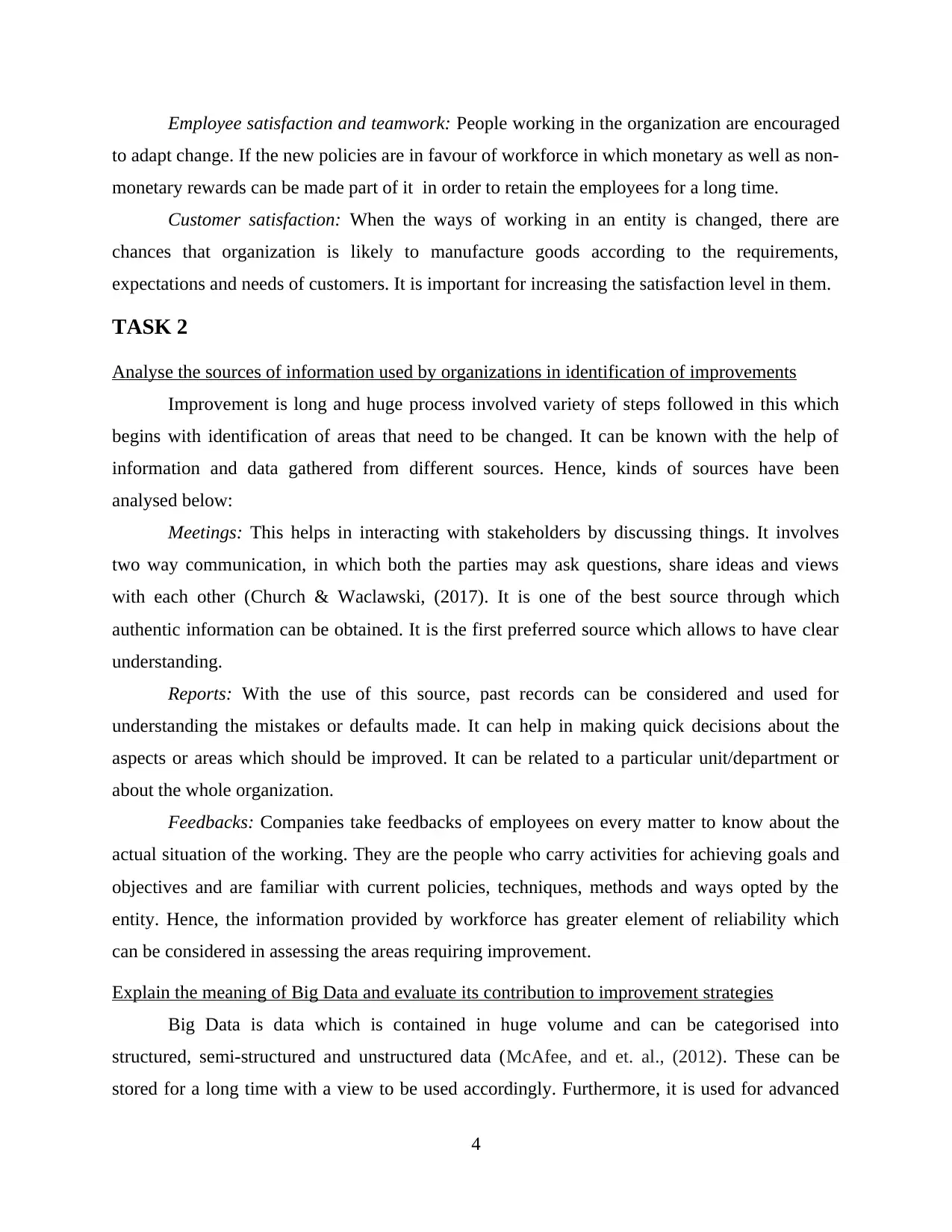
Employee satisfaction and teamwork: People working in the organization are encouraged
to adapt change. If the new policies are in favour of workforce in which monetary as well as non-
monetary rewards can be made part of it in order to retain the employees for a long time.
Customer satisfaction: When the ways of working in an entity is changed, there are
chances that organization is likely to manufacture goods according to the requirements,
expectations and needs of customers. It is important for increasing the satisfaction level in them.
TASK 2
Analyse the sources of information used by organizations in identification of improvements
Improvement is long and huge process involved variety of steps followed in this which
begins with identification of areas that need to be changed. It can be known with the help of
information and data gathered from different sources. Hence, kinds of sources have been
analysed below:
Meetings: This helps in interacting with stakeholders by discussing things. It involves
two way communication, in which both the parties may ask questions, share ideas and views
with each other (Church & Waclawski, (2017). It is one of the best source through which
authentic information can be obtained. It is the first preferred source which allows to have clear
understanding.
Reports: With the use of this source, past records can be considered and used for
understanding the mistakes or defaults made. It can help in making quick decisions about the
aspects or areas which should be improved. It can be related to a particular unit/department or
about the whole organization.
Feedbacks: Companies take feedbacks of employees on every matter to know about the
actual situation of the working. They are the people who carry activities for achieving goals and
objectives and are familiar with current policies, techniques, methods and ways opted by the
entity. Hence, the information provided by workforce has greater element of reliability which
can be considered in assessing the areas requiring improvement.
Explain the meaning of Big Data and evaluate its contribution to improvement strategies
Big Data is data which is contained in huge volume and can be categorised into
structured, semi-structured and unstructured data (McAfee, and et. al., (2012). These can be
stored for a long time with a view to be used accordingly. Furthermore, it is used for advanced
4
to adapt change. If the new policies are in favour of workforce in which monetary as well as non-
monetary rewards can be made part of it in order to retain the employees for a long time.
Customer satisfaction: When the ways of working in an entity is changed, there are
chances that organization is likely to manufacture goods according to the requirements,
expectations and needs of customers. It is important for increasing the satisfaction level in them.
TASK 2
Analyse the sources of information used by organizations in identification of improvements
Improvement is long and huge process involved variety of steps followed in this which
begins with identification of areas that need to be changed. It can be known with the help of
information and data gathered from different sources. Hence, kinds of sources have been
analysed below:
Meetings: This helps in interacting with stakeholders by discussing things. It involves
two way communication, in which both the parties may ask questions, share ideas and views
with each other (Church & Waclawski, (2017). It is one of the best source through which
authentic information can be obtained. It is the first preferred source which allows to have clear
understanding.
Reports: With the use of this source, past records can be considered and used for
understanding the mistakes or defaults made. It can help in making quick decisions about the
aspects or areas which should be improved. It can be related to a particular unit/department or
about the whole organization.
Feedbacks: Companies take feedbacks of employees on every matter to know about the
actual situation of the working. They are the people who carry activities for achieving goals and
objectives and are familiar with current policies, techniques, methods and ways opted by the
entity. Hence, the information provided by workforce has greater element of reliability which
can be considered in assessing the areas requiring improvement.
Explain the meaning of Big Data and evaluate its contribution to improvement strategies
Big Data is data which is contained in huge volume and can be categorised into
structured, semi-structured and unstructured data (McAfee, and et. al., (2012). These can be
stored for a long time with a view to be used accordingly. Furthermore, it is used for advanced
4
Paraphrase This Document
Need a fresh take? Get an instant paraphrase of this document with our AI Paraphraser
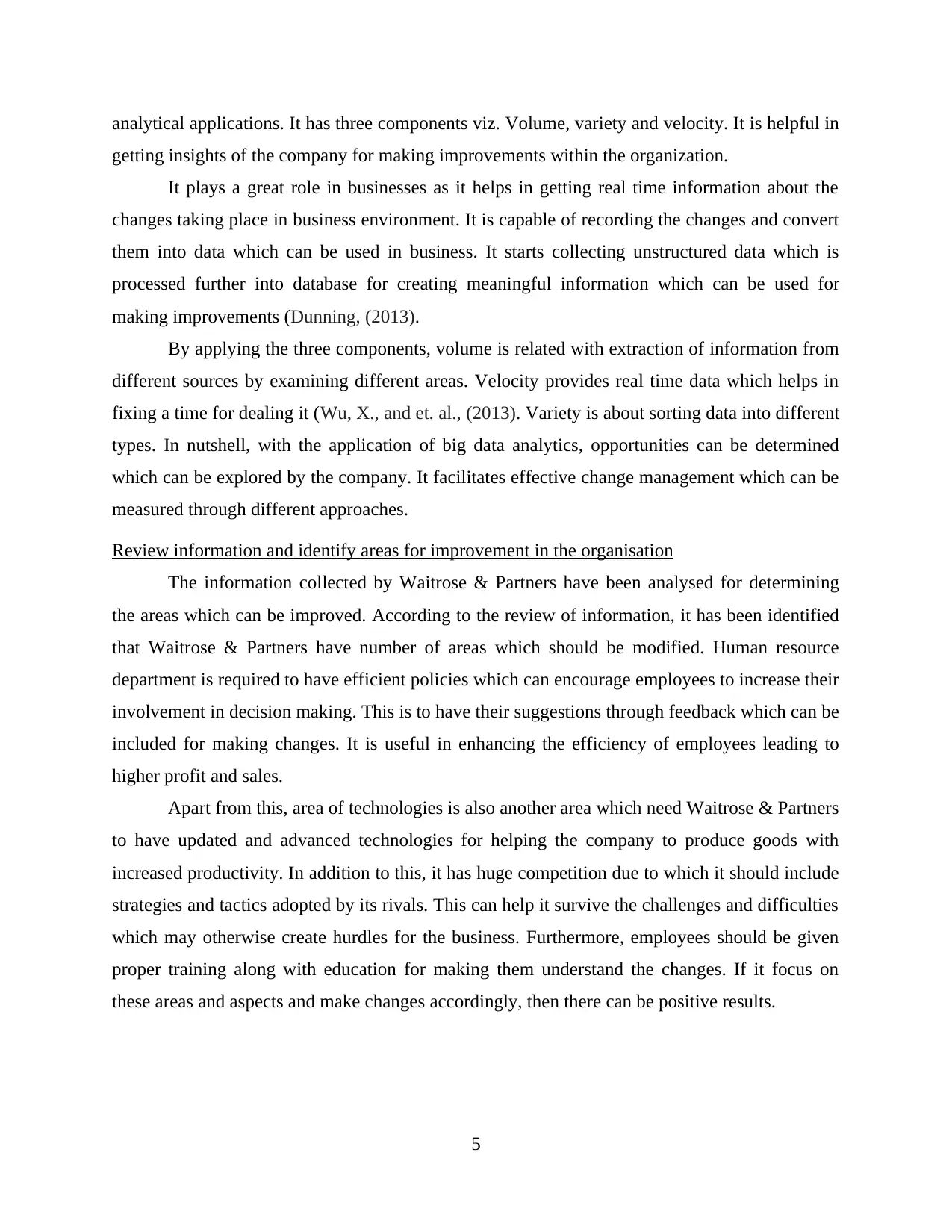
analytical applications. It has three components viz. Volume, variety and velocity. It is helpful in
getting insights of the company for making improvements within the organization.
It plays a great role in businesses as it helps in getting real time information about the
changes taking place in business environment. It is capable of recording the changes and convert
them into data which can be used in business. It starts collecting unstructured data which is
processed further into database for creating meaningful information which can be used for
making improvements (Dunning, (2013).
By applying the three components, volume is related with extraction of information from
different sources by examining different areas. Velocity provides real time data which helps in
fixing a time for dealing it (Wu, X., and et. al., (2013). Variety is about sorting data into different
types. In nutshell, with the application of big data analytics, opportunities can be determined
which can be explored by the company. It facilitates effective change management which can be
measured through different approaches.
Review information and identify areas for improvement in the organisation
The information collected by Waitrose & Partners have been analysed for determining
the areas which can be improved. According to the review of information, it has been identified
that Waitrose & Partners have number of areas which should be modified. Human resource
department is required to have efficient policies which can encourage employees to increase their
involvement in decision making. This is to have their suggestions through feedback which can be
included for making changes. It is useful in enhancing the efficiency of employees leading to
higher profit and sales.
Apart from this, area of technologies is also another area which need Waitrose & Partners
to have updated and advanced technologies for helping the company to produce goods with
increased productivity. In addition to this, it has huge competition due to which it should include
strategies and tactics adopted by its rivals. This can help it survive the challenges and difficulties
which may otherwise create hurdles for the business. Furthermore, employees should be given
proper training along with education for making them understand the changes. If it focus on
these areas and aspects and make changes accordingly, then there can be positive results.
5
getting insights of the company for making improvements within the organization.
It plays a great role in businesses as it helps in getting real time information about the
changes taking place in business environment. It is capable of recording the changes and convert
them into data which can be used in business. It starts collecting unstructured data which is
processed further into database for creating meaningful information which can be used for
making improvements (Dunning, (2013).
By applying the three components, volume is related with extraction of information from
different sources by examining different areas. Velocity provides real time data which helps in
fixing a time for dealing it (Wu, X., and et. al., (2013). Variety is about sorting data into different
types. In nutshell, with the application of big data analytics, opportunities can be determined
which can be explored by the company. It facilitates effective change management which can be
measured through different approaches.
Review information and identify areas for improvement in the organisation
The information collected by Waitrose & Partners have been analysed for determining
the areas which can be improved. According to the review of information, it has been identified
that Waitrose & Partners have number of areas which should be modified. Human resource
department is required to have efficient policies which can encourage employees to increase their
involvement in decision making. This is to have their suggestions through feedback which can be
included for making changes. It is useful in enhancing the efficiency of employees leading to
higher profit and sales.
Apart from this, area of technologies is also another area which need Waitrose & Partners
to have updated and advanced technologies for helping the company to produce goods with
increased productivity. In addition to this, it has huge competition due to which it should include
strategies and tactics adopted by its rivals. This can help it survive the challenges and difficulties
which may otherwise create hurdles for the business. Furthermore, employees should be given
proper training along with education for making them understand the changes. If it focus on
these areas and aspects and make changes accordingly, then there can be positive results.
5
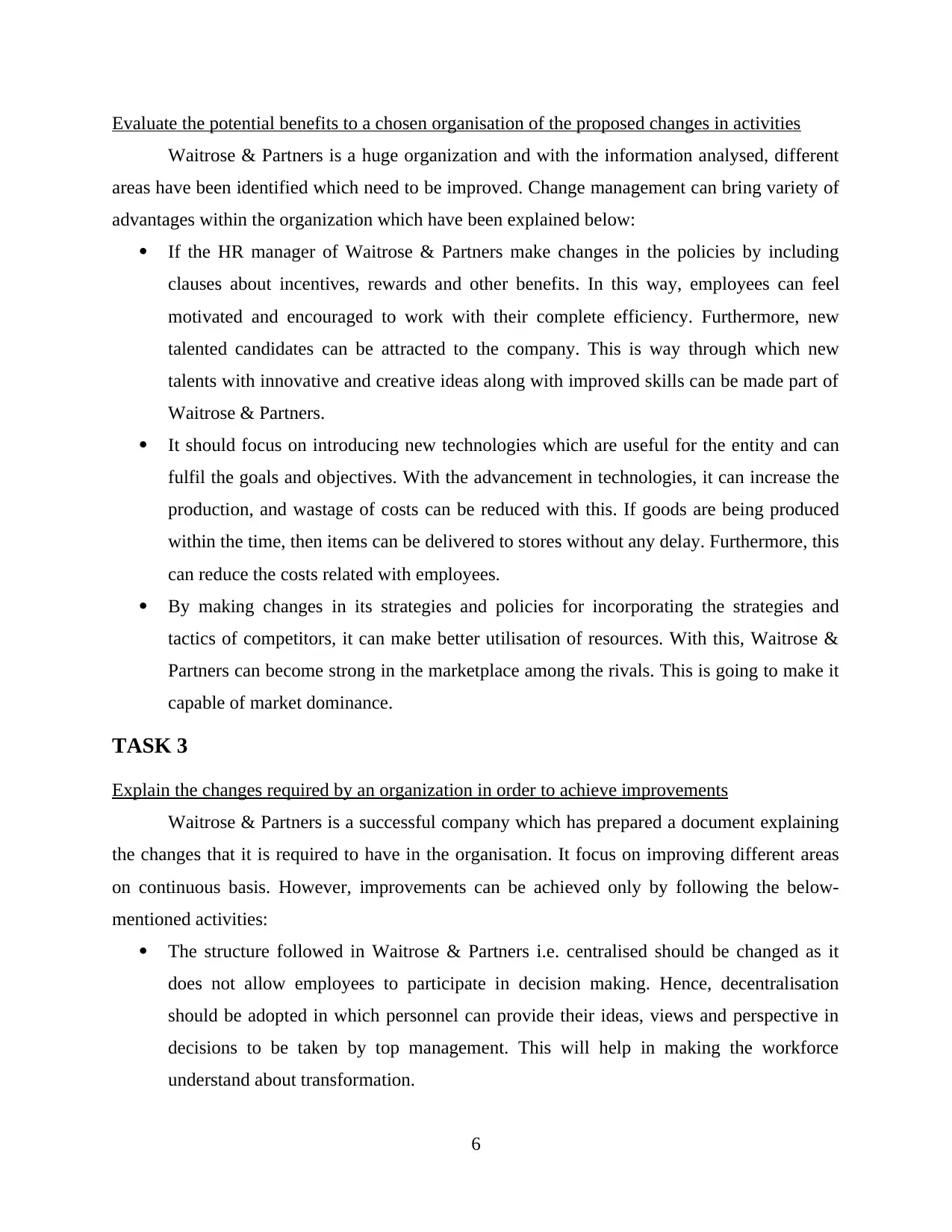
Evaluate the potential benefits to a chosen organisation of the proposed changes in activities
Waitrose & Partners is a huge organization and with the information analysed, different
areas have been identified which need to be improved. Change management can bring variety of
advantages within the organization which have been explained below:
If the HR manager of Waitrose & Partners make changes in the policies by including
clauses about incentives, rewards and other benefits. In this way, employees can feel
motivated and encouraged to work with their complete efficiency. Furthermore, new
talented candidates can be attracted to the company. This is way through which new
talents with innovative and creative ideas along with improved skills can be made part of
Waitrose & Partners.
It should focus on introducing new technologies which are useful for the entity and can
fulfil the goals and objectives. With the advancement in technologies, it can increase the
production, and wastage of costs can be reduced with this. If goods are being produced
within the time, then items can be delivered to stores without any delay. Furthermore, this
can reduce the costs related with employees.
By making changes in its strategies and policies for incorporating the strategies and
tactics of competitors, it can make better utilisation of resources. With this, Waitrose &
Partners can become strong in the marketplace among the rivals. This is going to make it
capable of market dominance.
TASK 3
Explain the changes required by an organization in order to achieve improvements
Waitrose & Partners is a successful company which has prepared a document explaining
the changes that it is required to have in the organisation. It focus on improving different areas
on continuous basis. However, improvements can be achieved only by following the below-
mentioned activities:
The structure followed in Waitrose & Partners i.e. centralised should be changed as it
does not allow employees to participate in decision making. Hence, decentralisation
should be adopted in which personnel can provide their ideas, views and perspective in
decisions to be taken by top management. This will help in making the workforce
understand about transformation.
6
Waitrose & Partners is a huge organization and with the information analysed, different
areas have been identified which need to be improved. Change management can bring variety of
advantages within the organization which have been explained below:
If the HR manager of Waitrose & Partners make changes in the policies by including
clauses about incentives, rewards and other benefits. In this way, employees can feel
motivated and encouraged to work with their complete efficiency. Furthermore, new
talented candidates can be attracted to the company. This is way through which new
talents with innovative and creative ideas along with improved skills can be made part of
Waitrose & Partners.
It should focus on introducing new technologies which are useful for the entity and can
fulfil the goals and objectives. With the advancement in technologies, it can increase the
production, and wastage of costs can be reduced with this. If goods are being produced
within the time, then items can be delivered to stores without any delay. Furthermore, this
can reduce the costs related with employees.
By making changes in its strategies and policies for incorporating the strategies and
tactics of competitors, it can make better utilisation of resources. With this, Waitrose &
Partners can become strong in the marketplace among the rivals. This is going to make it
capable of market dominance.
TASK 3
Explain the changes required by an organization in order to achieve improvements
Waitrose & Partners is a successful company which has prepared a document explaining
the changes that it is required to have in the organisation. It focus on improving different areas
on continuous basis. However, improvements can be achieved only by following the below-
mentioned activities:
The structure followed in Waitrose & Partners i.e. centralised should be changed as it
does not allow employees to participate in decision making. Hence, decentralisation
should be adopted in which personnel can provide their ideas, views and perspective in
decisions to be taken by top management. This will help in making the workforce
understand about transformation.
6
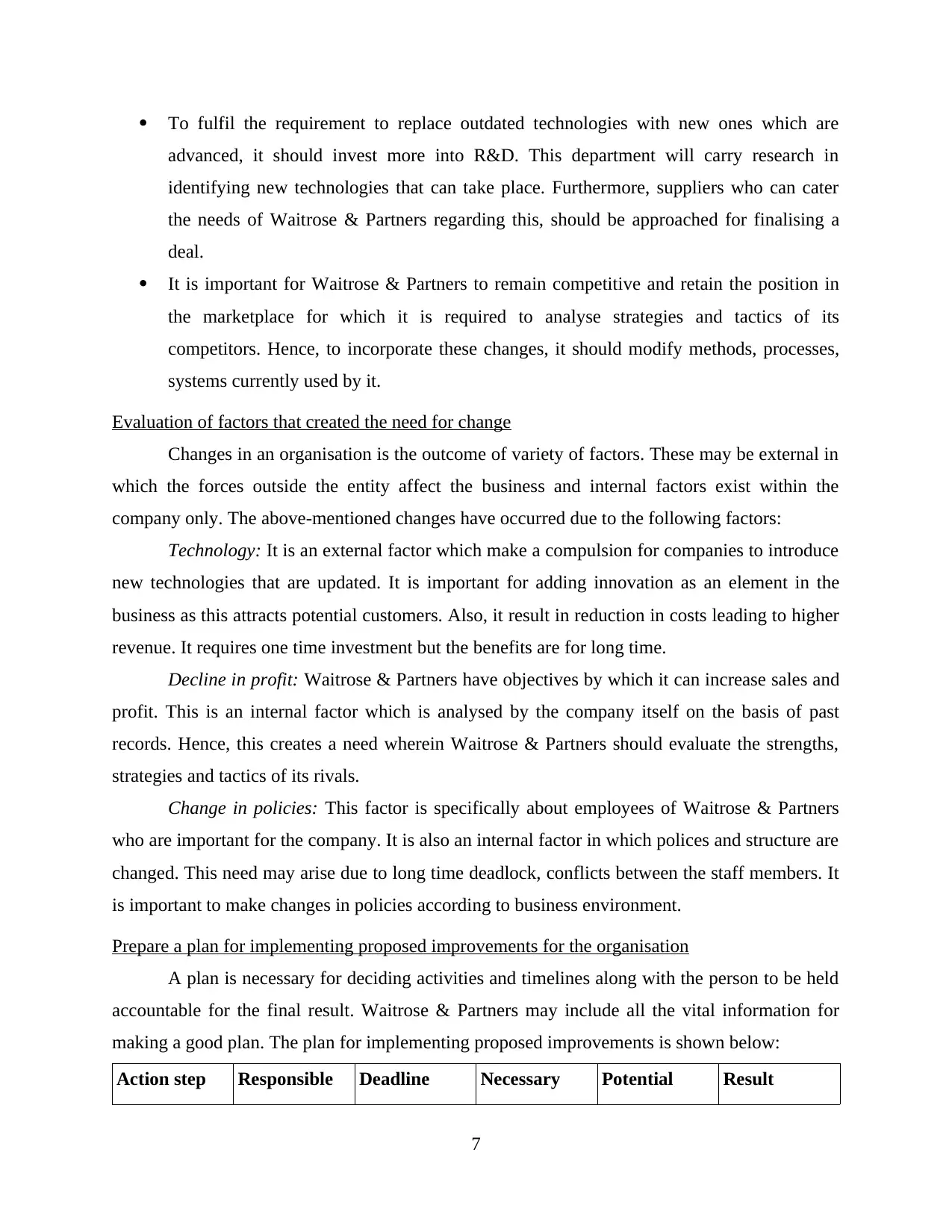
To fulfil the requirement to replace outdated technologies with new ones which are
advanced, it should invest more into R&D. This department will carry research in
identifying new technologies that can take place. Furthermore, suppliers who can cater
the needs of Waitrose & Partners regarding this, should be approached for finalising a
deal.
It is important for Waitrose & Partners to remain competitive and retain the position in
the marketplace for which it is required to analyse strategies and tactics of its
competitors. Hence, to incorporate these changes, it should modify methods, processes,
systems currently used by it.
Evaluation of factors that created the need for change
Changes in an organisation is the outcome of variety of factors. These may be external in
which the forces outside the entity affect the business and internal factors exist within the
company only. The above-mentioned changes have occurred due to the following factors:
Technology: It is an external factor which make a compulsion for companies to introduce
new technologies that are updated. It is important for adding innovation as an element in the
business as this attracts potential customers. Also, it result in reduction in costs leading to higher
revenue. It requires one time investment but the benefits are for long time.
Decline in profit: Waitrose & Partners have objectives by which it can increase sales and
profit. This is an internal factor which is analysed by the company itself on the basis of past
records. Hence, this creates a need wherein Waitrose & Partners should evaluate the strengths,
strategies and tactics of its rivals.
Change in policies: This factor is specifically about employees of Waitrose & Partners
who are important for the company. It is also an internal factor in which polices and structure are
changed. This need may arise due to long time deadlock, conflicts between the staff members. It
is important to make changes in policies according to business environment.
Prepare a plan for implementing proposed improvements for the organisation
A plan is necessary for deciding activities and timelines along with the person to be held
accountable for the final result. Waitrose & Partners may include all the vital information for
making a good plan. The plan for implementing proposed improvements is shown below:
Action step Responsible Deadline Necessary Potential Result
7
advanced, it should invest more into R&D. This department will carry research in
identifying new technologies that can take place. Furthermore, suppliers who can cater
the needs of Waitrose & Partners regarding this, should be approached for finalising a
deal.
It is important for Waitrose & Partners to remain competitive and retain the position in
the marketplace for which it is required to analyse strategies and tactics of its
competitors. Hence, to incorporate these changes, it should modify methods, processes,
systems currently used by it.
Evaluation of factors that created the need for change
Changes in an organisation is the outcome of variety of factors. These may be external in
which the forces outside the entity affect the business and internal factors exist within the
company only. The above-mentioned changes have occurred due to the following factors:
Technology: It is an external factor which make a compulsion for companies to introduce
new technologies that are updated. It is important for adding innovation as an element in the
business as this attracts potential customers. Also, it result in reduction in costs leading to higher
revenue. It requires one time investment but the benefits are for long time.
Decline in profit: Waitrose & Partners have objectives by which it can increase sales and
profit. This is an internal factor which is analysed by the company itself on the basis of past
records. Hence, this creates a need wherein Waitrose & Partners should evaluate the strengths,
strategies and tactics of its rivals.
Change in policies: This factor is specifically about employees of Waitrose & Partners
who are important for the company. It is also an internal factor in which polices and structure are
changed. This need may arise due to long time deadlock, conflicts between the staff members. It
is important to make changes in policies according to business environment.
Prepare a plan for implementing proposed improvements for the organisation
A plan is necessary for deciding activities and timelines along with the person to be held
accountable for the final result. Waitrose & Partners may include all the vital information for
making a good plan. The plan for implementing proposed improvements is shown below:
Action step Responsible Deadline Necessary Potential Result
7
Secure Best Marks with AI Grader
Need help grading? Try our AI Grader for instant feedback on your assignments.
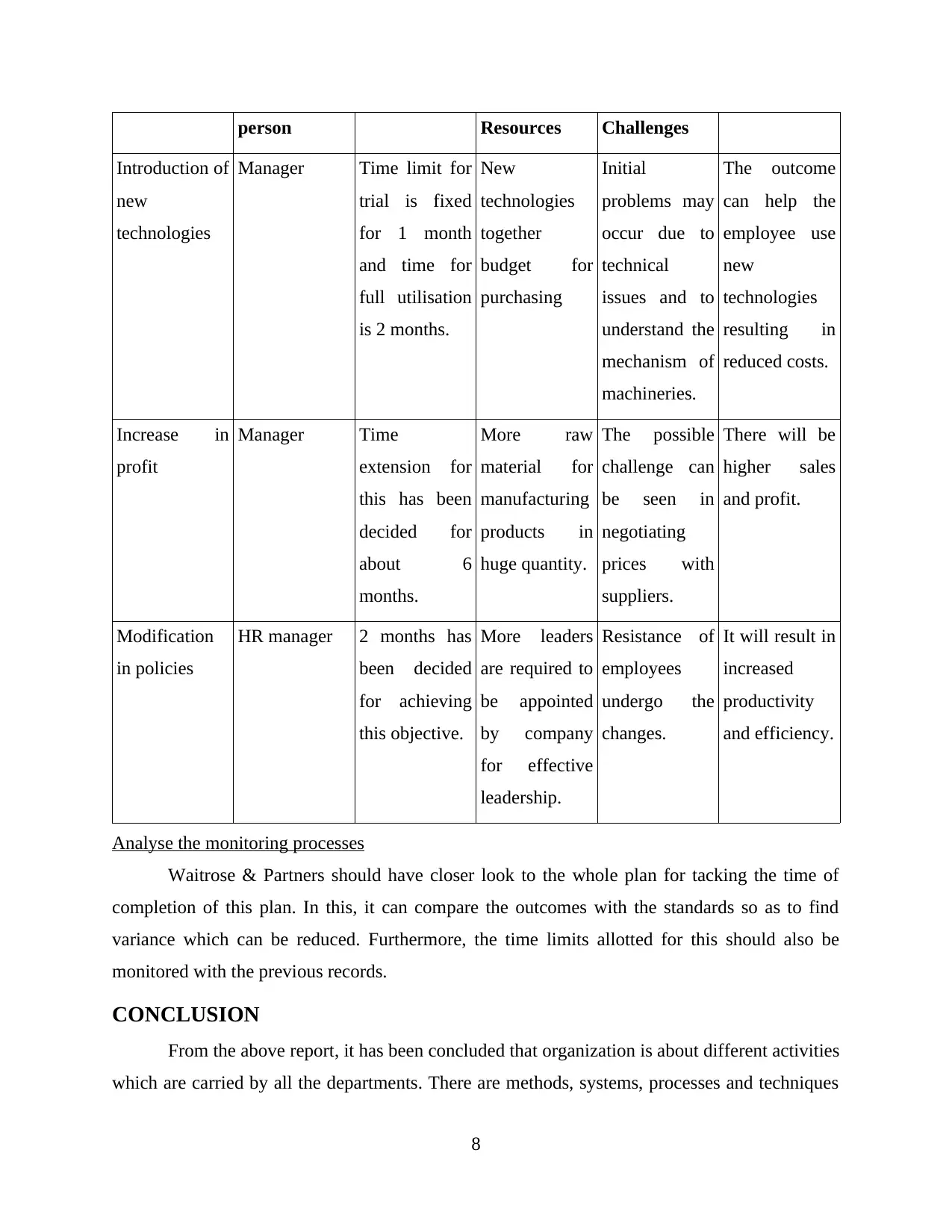
person Resources Challenges
Introduction of
new
technologies
Manager Time limit for
trial is fixed
for 1 month
and time for
full utilisation
is 2 months.
New
technologies
together
budget for
purchasing
Initial
problems may
occur due to
technical
issues and to
understand the
mechanism of
machineries.
The outcome
can help the
employee use
new
technologies
resulting in
reduced costs.
Increase in
profit
Manager Time
extension for
this has been
decided for
about 6
months.
More raw
material for
manufacturing
products in
huge quantity.
The possible
challenge can
be seen in
negotiating
prices with
suppliers.
There will be
higher sales
and profit.
Modification
in policies
HR manager 2 months has
been decided
for achieving
this objective.
More leaders
are required to
be appointed
by company
for effective
leadership.
Resistance of
employees
undergo the
changes.
It will result in
increased
productivity
and efficiency.
Analyse the monitoring processes
Waitrose & Partners should have closer look to the whole plan for tacking the time of
completion of this plan. In this, it can compare the outcomes with the standards so as to find
variance which can be reduced. Furthermore, the time limits allotted for this should also be
monitored with the previous records.
CONCLUSION
From the above report, it has been concluded that organization is about different activities
which are carried by all the departments. There are methods, systems, processes and techniques
8
Introduction of
new
technologies
Manager Time limit for
trial is fixed
for 1 month
and time for
full utilisation
is 2 months.
New
technologies
together
budget for
purchasing
Initial
problems may
occur due to
technical
issues and to
understand the
mechanism of
machineries.
The outcome
can help the
employee use
new
technologies
resulting in
reduced costs.
Increase in
profit
Manager Time
extension for
this has been
decided for
about 6
months.
More raw
material for
manufacturing
products in
huge quantity.
The possible
challenge can
be seen in
negotiating
prices with
suppliers.
There will be
higher sales
and profit.
Modification
in policies
HR manager 2 months has
been decided
for achieving
this objective.
More leaders
are required to
be appointed
by company
for effective
leadership.
Resistance of
employees
undergo the
changes.
It will result in
increased
productivity
and efficiency.
Analyse the monitoring processes
Waitrose & Partners should have closer look to the whole plan for tacking the time of
completion of this plan. In this, it can compare the outcomes with the standards so as to find
variance which can be reduced. Furthermore, the time limits allotted for this should also be
monitored with the previous records.
CONCLUSION
From the above report, it has been concluded that organization is about different activities
which are carried by all the departments. There are methods, systems, processes and techniques
8
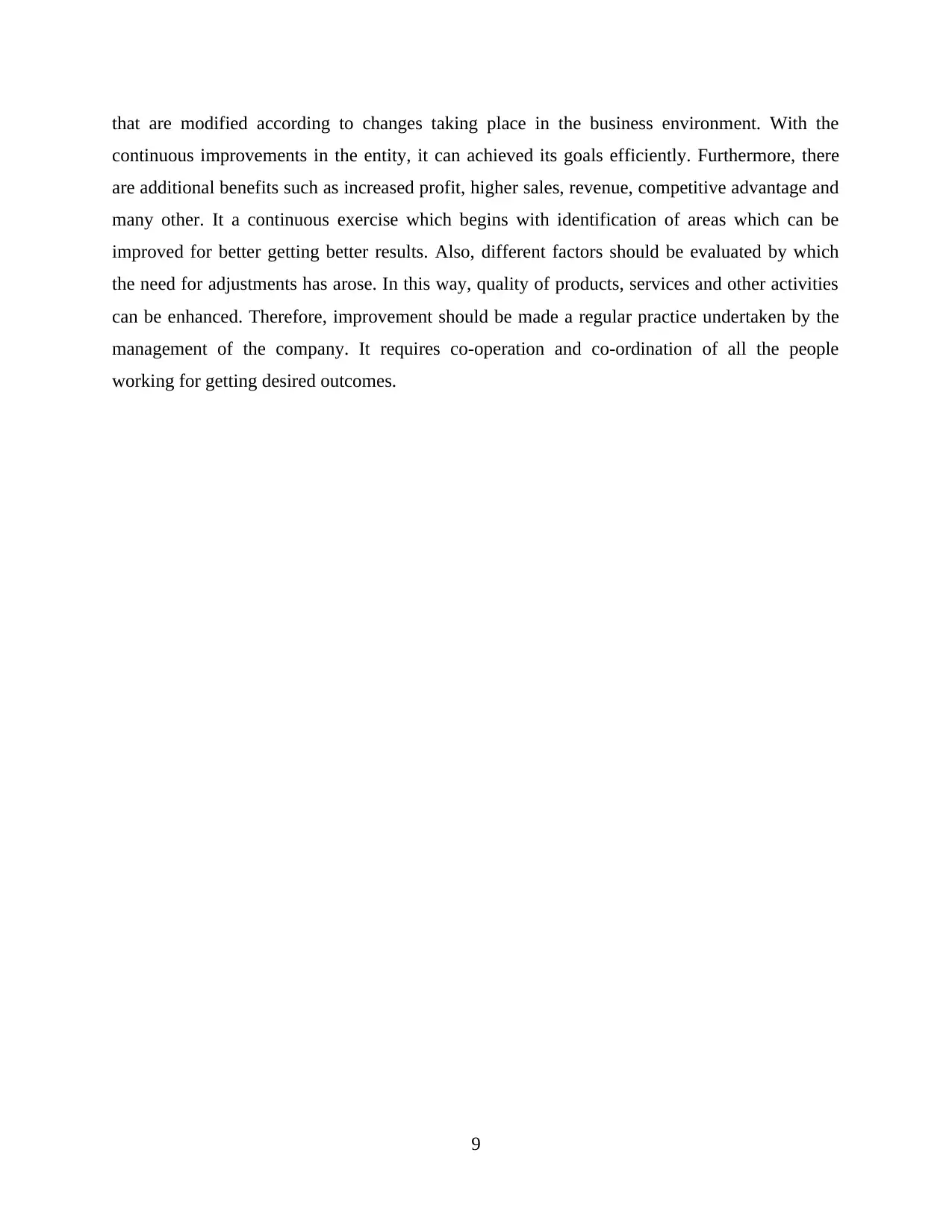
that are modified according to changes taking place in the business environment. With the
continuous improvements in the entity, it can achieved its goals efficiently. Furthermore, there
are additional benefits such as increased profit, higher sales, revenue, competitive advantage and
many other. It a continuous exercise which begins with identification of areas which can be
improved for better getting better results. Also, different factors should be evaluated by which
the need for adjustments has arose. In this way, quality of products, services and other activities
can be enhanced. Therefore, improvement should be made a regular practice undertaken by the
management of the company. It requires co-operation and co-ordination of all the people
working for getting desired outcomes.
9
continuous improvements in the entity, it can achieved its goals efficiently. Furthermore, there
are additional benefits such as increased profit, higher sales, revenue, competitive advantage and
many other. It a continuous exercise which begins with identification of areas which can be
improved for better getting better results. Also, different factors should be evaluated by which
the need for adjustments has arose. In this way, quality of products, services and other activities
can be enhanced. Therefore, improvement should be made a regular practice undertaken by the
management of the company. It requires co-operation and co-ordination of all the people
working for getting desired outcomes.
9
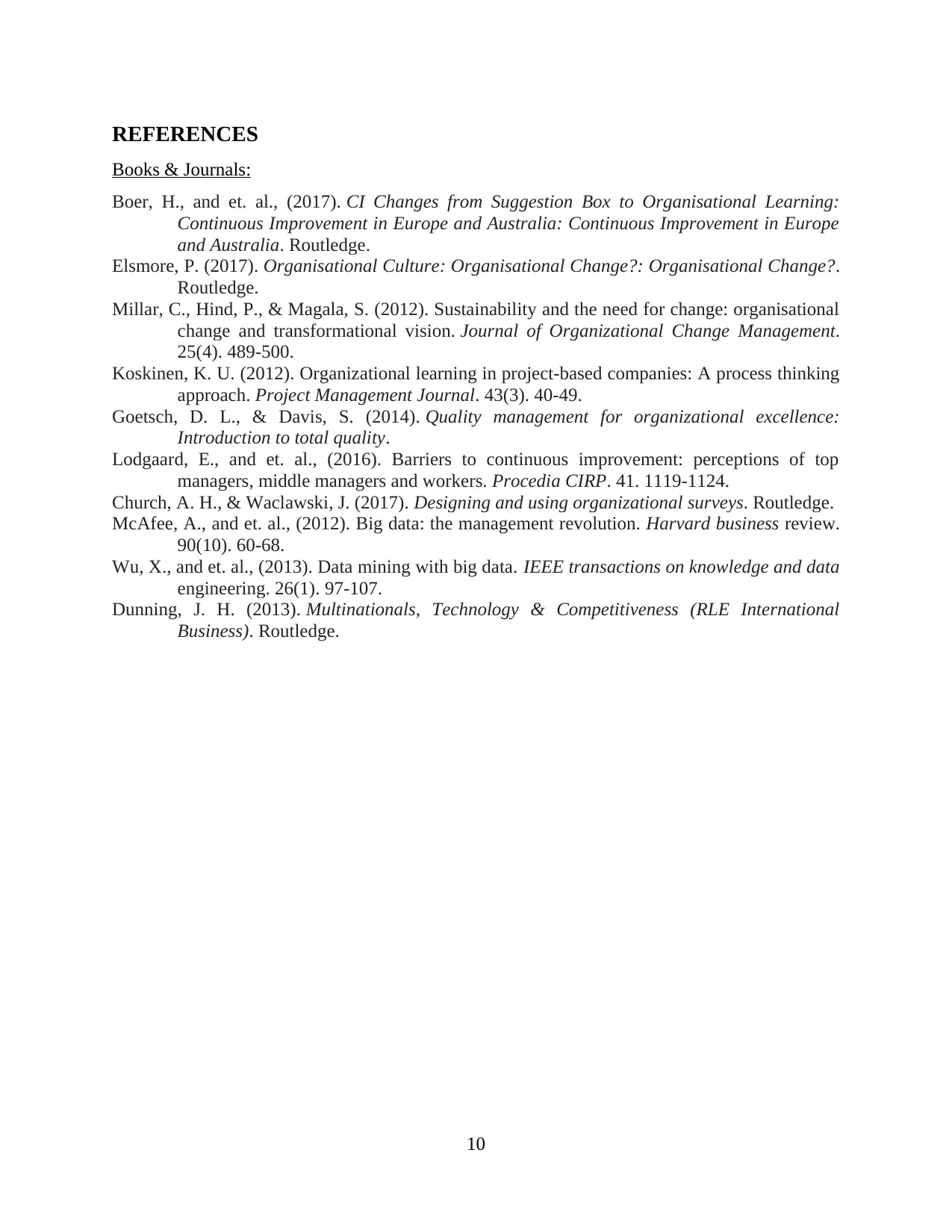
REFERENCES
Books & Journals:
Boer, H., and et. al., (2017). CI Changes from Suggestion Box to Organisational Learning:
Continuous Improvement in Europe and Australia: Continuous Improvement in Europe
and Australia. Routledge.
Elsmore, P. (2017). Organisational Culture: Organisational Change?: Organisational Change?.
Routledge.
Millar, C., Hind, P., & Magala, S. (2012). Sustainability and the need for change: organisational
change and transformational vision. Journal of Organizational Change Management.
25(4). 489-500.
Koskinen, K. U. (2012). Organizational learning in project-based companies: A process thinking
approach. Project Management Journal. 43(3). 40-49.
Goetsch, D. L., & Davis, S. (2014). Quality management for organizational excellence:
Introduction to total quality.
Lodgaard, E., and et. al., (2016). Barriers to continuous improvement: perceptions of top
managers, middle managers and workers. Procedia CIRP. 41. 1119-1124.
Church, A. H., & Waclawski, J. (2017). Designing and using organizational surveys. Routledge.
McAfee, A., and et. al., (2012). Big data: the management revolution. Harvard business review.
90(10). 60-68.
Wu, X., and et. al., (2013). Data mining with big data. IEEE transactions on knowledge and data
engineering. 26(1). 97-107.
Dunning, J. H. (2013). Multinationals, Technology & Competitiveness (RLE International
Business). Routledge.
10
Books & Journals:
Boer, H., and et. al., (2017). CI Changes from Suggestion Box to Organisational Learning:
Continuous Improvement in Europe and Australia: Continuous Improvement in Europe
and Australia. Routledge.
Elsmore, P. (2017). Organisational Culture: Organisational Change?: Organisational Change?.
Routledge.
Millar, C., Hind, P., & Magala, S. (2012). Sustainability and the need for change: organisational
change and transformational vision. Journal of Organizational Change Management.
25(4). 489-500.
Koskinen, K. U. (2012). Organizational learning in project-based companies: A process thinking
approach. Project Management Journal. 43(3). 40-49.
Goetsch, D. L., & Davis, S. (2014). Quality management for organizational excellence:
Introduction to total quality.
Lodgaard, E., and et. al., (2016). Barriers to continuous improvement: perceptions of top
managers, middle managers and workers. Procedia CIRP. 41. 1119-1124.
Church, A. H., & Waclawski, J. (2017). Designing and using organizational surveys. Routledge.
McAfee, A., and et. al., (2012). Big data: the management revolution. Harvard business review.
90(10). 60-68.
Wu, X., and et. al., (2013). Data mining with big data. IEEE transactions on knowledge and data
engineering. 26(1). 97-107.
Dunning, J. H. (2013). Multinationals, Technology & Competitiveness (RLE International
Business). Routledge.
10
Paraphrase This Document
Need a fresh take? Get an instant paraphrase of this document with our AI Paraphraser

11
1 out of 14
Related Documents
Your All-in-One AI-Powered Toolkit for Academic Success.
+13062052269
info@desklib.com
Available 24*7 on WhatsApp / Email
![[object Object]](/_next/static/media/star-bottom.7253800d.svg)
Unlock your academic potential
© 2024 | Zucol Services PVT LTD | All rights reserved.





